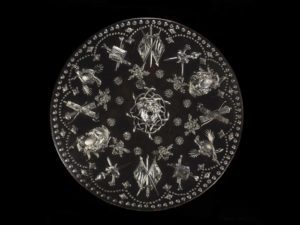Bonnie Prince Charlie and the Jacobites is a new exhibition at Edinburgh’s National Museum of Scotland.
It shows how he attempted to achieve his dream of becoming the King of Scotland.
Charles Edward Stuart reached Scottish soil for the first time in his life in 1745 at Eriskay. The Bonnie Prince was born in exile in Rome, and he sought to return a Catholic Stuart to the thrones of England, Scotland, and Ireland.
The Jacobites (from the followers of James, Jacobus) emerged after the Glorious Revolution of 1688, in which the Protestant William of Orange deposed James II. After several failed challenges, Charles represented the final chance for the Jacobites of retaking political power.
Visitors are led from the genesis of the Jacobite cause, through the struggles of the Stuarts in exile, to the massacre at Culloden and Charles’s death back in Rome. The exhibits have been gathered together from public and private collections from across Europe. Through objects, artwork, texts and the spoken word, the full and wistful tale of the Jacobites is told.

A portrait of Bonnie Prince Charlie
James II, the Bonnie Prince’s grandfather, died in exile at Saint-Germain-en-Laye. Louis XIV had given him use of the royal château, and the exiled Jacobite court functioned amidst its grandeur. James’ striking suit of armour is on display, the last to be made for a British monarch.
Near this is encased the golden ampulla which contained the oil used to anoint Charles I at his Scottish coronation. There is even an ornate little signet ring given to a loyal subject by James on the night he fled London in 1688. One is truly face to face with history; it gives one pause for thought to consider just how these items survived such a turbulent time in British history.
In the aftermath of the Revolution William of Orange’s desire to snuff out all opposition led to the gruesome Glencoe Massacre. An example was made of the MacDonald clan, who had been slow to pledge allegiance to the new monarch. Displayed here is the handwritten order given by Sir John Dalrymple, the Secretary of State for Scotland, to ‘put all to the sword under 70’ of those in the clan. It was arranged that the Regiment of Foot of the Earl of Argyll would be billeted with the MacDonald clan, and indeed they were given a hospitable reception in the Highland spirit.
The MacDonalds were soon to be murdered in their beds, with the women and children left to perish from exposure. The brutality of the militia, justified by ‘by the King’s special command,’ only increased support for the Jacobite cause.

A decorative targe
A truly fascinating object, and one of the exhibition centrepieces, is the Highland targe (shield) given to Charles by the Duke of Perth several years before his ill-fated Scottish adventure. The rear is made of jaguar skin, and front and centre lies the head of Medusa. Charles was thus being compared to Perseus, the slayer of the monster. It was being implied that this modern-day hero would return and redeem his country from the evils which had befallen it.
Charles was described by the Spanish ambassador to St. Petersburg as “the most perfect Prince I have ever met in my life.” There was plenty of propaganda used to try and maintain this image. An Allan Ramsay portrait on display shows Charles at the Palace of Holyroodhouse, which he had taken after being cheered into Edinburgh by a great crowd of around 20,000 spectators. The portrait shows Charles on the eve of invading England, and so the insignia of the Order of the Garter is prominently displayed with calculated precision.
A later portrait by John Pettie is also displayed, which is a reimagining of the Prince entering the Palace ballroom. Again, the star of the Order stands out, as does the tartan. The ball itself was a literary invention of Walter Scott in Waverley, and the romanticism in Pettie’s work is certainly apparent. Propaganda did not just come from the painting brush, however.

A painting of the Young Pretender, by John Pettie
A superb collection of wine glasses and silverware on display bears subtle Jacobite imagery; for example the white rose which represented James III.
Ramsay’s portrait shows a man, bonnie at a push, of charisma and purpose. Soon, however, would come the disaster at Culloden. The Jacobites were routed, partly through Charles’s tactical blunders. The Duke of Cumberland became known as “the butcher,” after the hunting down and killing of injured and fleeing rebels. Lord Lovat was executed in the aftermath, as were many of the nobility with Jacobite sympathies, and on display is the very block he was executed on. Lovat suffers the historical ignominy of being the last person in Britain to be executed through beheading.
After Culloden Charles slipped away to France with the help of Flora MacDonald on Benbecula. There was a £30,000 bounty on his head. When the Old Pretender died Pope Clement XIII refused to bestow legitimacy upon Charles, and he died a broken man in Rome. His remains lie alongside those of his parents and brother in Saint Peter’s Basilica. At the close of the exhibition stand the original marble grave markers, which are on loan from the Scots College.
Bonnie Prince Charlie and the Jacobites runs until November 12.
TAGS

